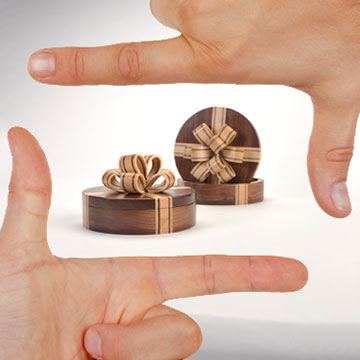 Composition
Composition
By Jon Deck
Creating a well-lit, properly-focused image of adequate resolution means little if the scene you’ve shot is unclear to the viewer. The composition of your photo needs to communicate to your audience. This is especially true of photos in a step-by-step series that instructs a how-to message.
Choose your background carefully
Enough cannot be said about this basic element. More photos have been ruined by a poor choice of background than poor shooting skills. When it comes to a background, simpler is better. Avoid brash colors or patterns. Resist the temptation to shoot against carpeting or sheets. Fabrics are tough to control, and lines and creases never seem to disappear. Paper is the popular choice for amateurs and professionals alike. A trip to Amazon.com online will offer rolls of photo background paper in many colors, for a decent price. White should be your first choice, followed by a light neutral or gray. They ship in long rectangular boxes that you should keep to store your roll paper in between shoots.
Keep in mind what you’re shooting. If your subject is something small and shiny like jewelry, you can consider a textured background. A heavily textured piece, like a wood spirit, would photograph better on a smooth background. A chainsaw carving would be best shot outdoors than in a garage, unless you had a backdrop large enough to hold the entire carving. Then again, if outdoors means there’s an old car, a garden shed, or a chainlink fence behind it, then no. Be aware that the camera will see what is not apparent to you.
For a step-by-step series, shooting on roll paper may not be practical, especially if power tools are involved. I suggest you choose the best area of your shop to shoot in. If you need to, invest in a fresh piece of plywood for a clean benchtop, and remove any background distractions. Nobody wants to see how many tools, license plates, and calendars you have on your walls. A clean organized shop is a perfect background for your images.
Clean up your set area
I’ve often heard that a clean desk is the sign of a sick mind. It’s quite true that any industrious person lives in a bit of clutter, but that has no place in a photo that is illustrating a phase of producing a project. Be sure that there is nothing in your set that distracts from the focus of the image and its message. Show only the tools and supplies used in the step that you’re capturing. Don’t let any items that are in your shot overpower the image—they are only props. If they provide too much clutter, remove them from the set or move them to a background position. Tidy up between scenes. If your first shot left a considerable amount of dust or woodchips, sweep them up before setting up the next scene. Keep your project the focus of the series from start to finish.
Demonstrating the procedure
A major flaw in many step-by-steps, is the lack of physical involvement of the craftsman. Many times the workpiece is shown in a series of photos of the project after each step has been accomplished. Although the progression is helpful, it’s far better to show the tools in use. Sometimes showing just how a tool is held to perform a task can make the difference in success or failure to the student of your images. Hands give scale to the project as well, showing if a project is handled in a palm or between fingertips. A Word About Hands… if you do show hands in a photo, make sure they are not a distraction in themselves. Make sure your hands are clean, with fingernails trimmed and cleaned. And if safety is an issue, make sure you’re wearing the proper gloves for the step you are illustrating. Hands can get in the way, obstructing the step they are performing. Be sure the camera sees the work that your hands are doing. Don’t try shooting alone, with your hands demonstrating a step (I speak from experience on this). You will never be satisfied with your photo. Better to get someone to shoot your hands in the process, or have someone who will be your hand model to sit in while you take the shot. If you’re working on machinery, it’s usually better to turn off the tool when taking the picture.
Whatever the procedure is, make sure the camera has the best angle to see the action. Clean, simple, meaningful images will create the best results for publishing.





